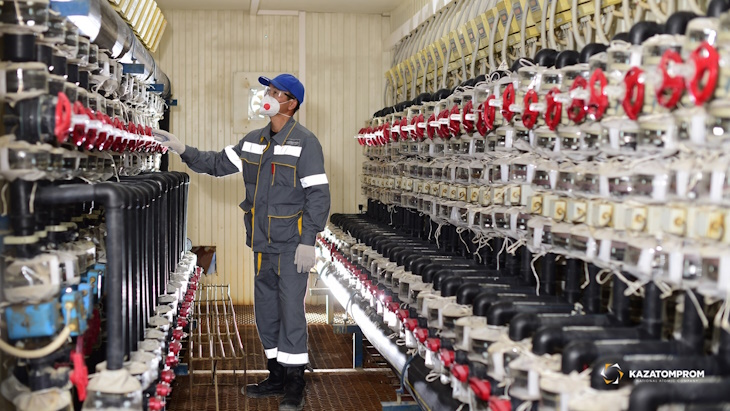Kazatomprom lowers 2025 uranium production expectations
Kazatomprom has cut its uranium production guidance for 2025 by 5000 tU, citing uncertainties in sulphuric acid supply - but 2025 production is still expected to be higher than 2024.

(Image: Kazatomprom)
Announcing its half-year financial results today, the national atomic company's CEO Meirzhan Yussupov said the company had demonstrated "robust financial results" for the six months to 30 June, with a 13% increase in revenue and a 27% growth in net profit to KZT283 billion (USD493 million). The company's recent receipt of a pilot production licence for Inkai 3 block and an exploration licence for the East Zhalpak block, as well as the extension of the exploration period at Inkai 2, demonstrate strategic moves aimed at addressing potential supply and demand imbalances.
"Amid our continued success in long-term contracting activity, Kazatomprom had initially intended to ramp up its 2025 production to 100% of Subsoil Use Agreement levels," Yussupov, said. "However, the uncertainty around the sulphuric acid supplies for 2025 needs and delays in the construction works at the newly developed deposits resulted in a need to re-evaluate our 2025 plans."
Kazatomprom now expects its 2025 production to be between 25,000 and 26,500 tU (on a 100% basis), down from its initial intentions for 2025 production volumes of 30,500-31,500 tU. This would represent a 12% growth from its 2024 guidance, Kazatomprom said.
Today's announcement follows on from the half-year trading update issued on 1 August, when the company increased its 2024 production guidance based on year-to-date production rates but warned that limited access to sulphuric acid and delays in the construction schedule at newly developed deposits could impact future production.
Delays in the construction of surface facilities and infrastructure, a consequence of the extended timelines required for the development and subsequent approval of project design documentation, have resulted in a "significant shift" in production schedules at newly developed projects, the company said. A "significant portion" of the adjusted 2025 production is attributed to construction delays at JV Budenovskoye LLP, where 2025 production is now expected to be 1300 tU instead of the previously approved 4000 tU.
Continuing uncertainty about supplies of sulphuric acid - a key reagent in Kazatomprom's in-situ leach operations - has significantly impacted 2025 production plans, with consequences of supply deficits over 2023-24 having a different degree of impact on uranium mining entities and their production rates depending on the geological structure of the deposits.
Kazatomprom said it has a "comfortable level of inventories" to fulfil its existing contractual commitments in 2025, and it also usually reserves a segment of its annual production as uncommitted. This strategic approach enables it to capitalise on emerging opportunities and adapt to market fluctuations to mitigate risks effectively and meet contractual obligations "even amidst production-related challenges".
"Taking into consideration high level of uncertainties related to the sulphuric acid supply and construction delay challenges, no decision has been taken regarding mine development activity and production volumes for 2026 and beyond," the company said, adding that it expects to announce its 2026 production plans "not earlier than a year from now".
Researched and written by World Nuclear News
- China Institute of Atomic Energy
- Nuclear Power Institute of China
- Southwestern Institute of Physics
- China Nuclear Power Operation Technology Corporation, Ltd.
- China Nuclear Power Engineering Co., Ltd.
- China Institute for Radiation Protection
- Beijing Research Institute of Uranium Geology (BRIUG)
- China Institute of Nuclear Industry Strategy (CINIS)
- China Nuclear Mining Science and Technology Corporation


